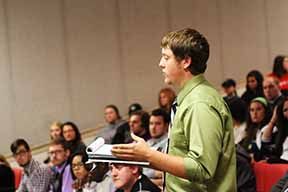Students Speak-Up: Pepper AU administration with questions about faculty cuts

Student Senate Vice President Brent Rossman was one of the students to question Ashland administration during the annual Student Senate Speak Up.
October 8, 2014
Ashland University barely avoided not being able to pay its employees over the summer, according to Interim President William Crothers.
Crothers was speaking to a packed Hawkins Conard Student Center auditorium during Tuesday’s Student Speak-Up. The event, organized by student senate, allowed students to voice any questions, complaints, concerns or positive feedback they had for the university’s administration.
“This institution, frankly, has been spending well beyond its means,” Crothers said. “At the end of this summer, we did not have the capability of making one more payroll for the institution. If we had had one more payroll, people would have not gotten paid.”
This prompted early budget cuts in the summer, leading to the elimination of six staff positions. The staff cuts along with other expense cuts throughout the university saved $2.1 million from the budget.
Nearly all the questions raised concerned the faculty cuts announced last week, focusing mainly on the potential impact to the quality of education. These concerns were heard by the administration, but the focus remained on the financial necessity of these moves.
According to Crothers, further steps were necessary to ensure the university becomes financially solvent. An analysis of the financial productivity of academic departments was done, which identified areas that were not financially productive.
“We have, or rather we had, too many faculty who were not teaching a full load of credits,” Crothers said.
“In fact, we had too many faculty who were not producing enough student credit hours to pay their own salary and expenses.”
Crothers and Interim Provost Doug Fiore went through these numbers, identifying departments and individuals to be cut.
Crothers said they then consulted with the deans before final cuts were made, which Crothers said will save the institution $1.7 million in salary and other expenses.
“That has removed us from the financial edge as an institution. It gives us the flexibility to build a budget for the next year and meet some of the financial needs that we know will be coming in the next budget cycle,” Crothers said. “I don’t anticipate any other reductions.”
Students also expressed concern that, in light of the academic prioritization process that is underway, these cuts were premature.
However, Crothers emphasized these cuts were budget-cutting moves, where the prioritization process will result in money being reallocated, not removed from the budget.
This current round of cuts was needed in order to keep the institution financially solvent, and to avoid further financial challenges.
“We were operating so close to the edge that we would run the risk of defaulting on our bank covenants, on our loans, and to go for two years before we could create any reductions through the prioritization process was too big a risk for the institution,” Crothers said.
All of the cuts were made with the intention to reduce the university’s cost. In addition, Scott Van Loo, the vice president of enrollment management and marketing, was able to report some signs of long-term growth for the university as a result of the tuition reset.
Van Loo reported the university’s application pool has increased by 20 percent in the midst of declining Ohio high school graduation numbers, for which Ashland relies on for 90 percent of its students.
Van Loo also spoke about an increase in AU’s retention numbers, which he credits to the implementation of the new advising model last year.
Despite this modest success, Van Loo was still disappointed in the results of the tuition reset, which failed to attract a larger first year class. The university did see an increase in new students though, due to an increase in the number of transfer students that came to AU.
He is also seeing positive responses to the new “extraordinary” campaign, which seeks to communicate the extraordinary work done at the university both internally and externally with prospective students.
In order to ensure excellent teaching continues, Fiore told students about his plans to work with the faculty senate to implement a post-tenure review process, something done at other universities that has not been implemented at AU.
“There’s something that some might argue is a process, but its a very lax process, said Fiore, “and tenured faculty, just like administrators who are not tenured, just like students in the classroom need to have their performance reviewed on a regular basis.”
Students also expressed their continued concerns for the potential growth in class size and faculty-to-student ratio due to these faculty cuts. Fiore said that the goal is the smallest class sizes that are financially beneficial for the institution, while Stephen Storck, vice president of business affairs, said that while a small faculty-to-student ratio is appealing, a previous institution he worked at found no empirical data to support better learning outcomes from smaller faculty-to-student ratios.
“We have well over 200 adjuncts and part-time faculty and they touch virtually every program on campus,” Storck said. In addition to the full-time faculty, you have opportunities to be taught by adjuncts as well. They bring a whole different set of experiences to the classroom. I think it would be a mistake for any student to leave here tonight thinking that because we have 15 fewer full-time faculty members next year that the quality of your education is going to be diminished.”
Despite these cuts, Crothers is optimistic for the future of Ashland University.
“We were not in a position to spend a lot of time making the decisions we made,” he said. “We had to make them in the long-term interest of the institution, but that’s behind us. We’ve got a different future today than we had even two or three weeks ago.”

